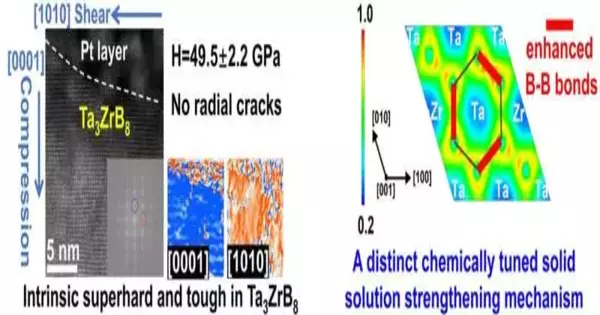Cutting and drilling tools, structural components, protective coatings, abrasives, and materials with superior mechanical strengths are essential to numerous modern industries and scientific endeavors. By introducing solute atoms into the crystal lattice to create local distortions that impede dislocation motion and plastic deformation, solid solution strengthening is a well-established method for increasing metal hardness. This results in increased strength but decreased ductility and toughness.
Superhard materials, on the other hand, with a Vickers hardness HV greater than 40 GPa exhibit high strength but low toughness through a unique mechanism governed by brittle bond deformation, illustrating yet another prominent case of the traditional strength-toughness tradeoff dilemma. A viable strategy for tuning the main load-bearing bonds in these strong but brittle materials in order to simultaneously enhance the peak stress and related strain range is required to solve this less-studied and poorly understood problem.
“This discovery emphasizes the critical role of properly matched contrasting relative electronegativity of solute and solvent atoms in creating concurrent strengthening and toughening, and it opens a promising avenue for rational design of enhanced mechanical properties in a broad class of transition-metal borides,”
Professor Kan Zhang’s team from Jilin University.
A chemically tuned solid solution approach that simultaneously achieves enhanced hardness and toughness in ternary Ta1-xZrxB2 based on the superhard transition-metal diboride TaB2 was demonstrated by the team of professor Kan Zhang from Jilin University using a combination of experimental and theoretical methods. In order to prevent charge depletion on the primary load-bearing B-B bonds during indentation, the solute atom Zr, which has a lower electronegativity than the solvent atom Ta, is introduced. This results in prolonged deformation with a significantly higher strain range and peak stress.
“This finding opens a promising avenue for rational design of enhanced mechanical properties in a large class of transition-metal borides,” Zhang stated. “This finding highlights the crucial role of properly matched contrasting relative electronegativity of solute and solvent atoms in creating concurrent strengthening and toughening.” It is anticipated that this method of simultaneously optimizing strength and toughness by chemically tuning the main load-bearing bonding charge induced by solute atoms will work in a wider range of materials, such as nitrides and carbides.”
The study has been published in the Research Journal.
More information: Xinlei Gu et al, Solving Strength–Toughness Dilemma in Superhard Transition-Metal Diborides via a Distinct Chemically Tuned Solid Solution Approach, Research (2023). DOI: 10.34133/research.0035





